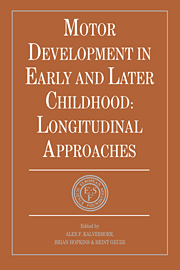Book contents
- Frontmatter
- Contents
- List of contributors
- Foreword
- Preface
- SETTING THE SCENE
- SECTION I BIOLOGICAL BASIS OF MOTOR DEVELOPMENT
- SECTION II DEVELOPMENT OF BODY POSTURE AND GOAL-DIRECTED REACHING
- 6 Early postnatal development of posture control: normal and abnormal aspects
- 7 Studying the development of goal-directed behaviour
- 8 Development of motor functions: a ‘developmental neurological’ approach
- SECTION III MOTOR DEVELOPMENT, EARLY COMMUNICATION AND COGNITION
- SECTION IV ACQUISITION OF SKILLS
- SECTION V MOTOR DEVELOPMENT AND HANDICAP
- SECTION VI METHODOLOGICAL AND CONCEPTUAL CONSIDERATIONS
- Epilogue: description versus explanation
- Index
6 - Early postnatal development of posture control: normal and abnormal aspects
from SECTION II - DEVELOPMENT OF BODY POSTURE AND GOAL-DIRECTED REACHING
Published online by Cambridge University Press: 05 May 2010
- Frontmatter
- Contents
- List of contributors
- Foreword
- Preface
- SETTING THE SCENE
- SECTION I BIOLOGICAL BASIS OF MOTOR DEVELOPMENT
- SECTION II DEVELOPMENT OF BODY POSTURE AND GOAL-DIRECTED REACHING
- 6 Early postnatal development of posture control: normal and abnormal aspects
- 7 Studying the development of goal-directed behaviour
- 8 Development of motor functions: a ‘developmental neurological’ approach
- SECTION III MOTOR DEVELOPMENT, EARLY COMMUNICATION AND COGNITION
- SECTION IV ACQUISITION OF SKILLS
- SECTION V MOTOR DEVELOPMENT AND HANDICAP
- SECTION VI METHODOLOGICAL AND CONCEPTUAL CONSIDERATIONS
- Epilogue: description versus explanation
- Index
Summary
INTRODUCTION
Recent research on the development of human voluntary motor skills, cognitive function and communication abilities is showing increasing evidence that these skills are strongly influenced by the infant's development of independent stability and mobility (Acredolo & Evans, 1980; Richards & Rader, 1981; Bertenthal, Campos & Barret, 1984). For example, the change from egocentric to objective coding of objects in space occurs between 6 and 9 months and is specifically associated with the onset of independent mobility (Bertenthal et al., 1984). Research has also shown that postural support allows the manifestation of reaching behaviours which would otherwise be impossible for the neonate to perform (von Hofsten, 1979; Amiel-Tisson & Grenier, 1980). In order to understand better the link between postural development and the development of higher brain function it is important to have a base of knowledge concerning the progressive development of posture control during infancy and early chilhood.
The development of balance and mobility can be viewed as an emergent property, with certain critical components which can be identified as rate-limiting or, conversely, those which push the system to the new level of control when they have matured. It is the aim of this chapter (a) to summarize the longitudinal and cross-sectional research on both normal and abnormal development of postural control in infancy and childhood (unfortunately, there are few longitudinal studies available), and (b) to analyse the time frame of the development of individual nervous system and muscular subcomponents which contribute to the development of independent stability and to discuss the contributions of each to its emergence.
- Type
- Chapter
- Information
- Motor Development in Early and Later ChildhoodLongitudinal Approaches, pp. 89 - 108Publisher: Cambridge University PressPrint publication year: 1993
- 3
- Cited by



